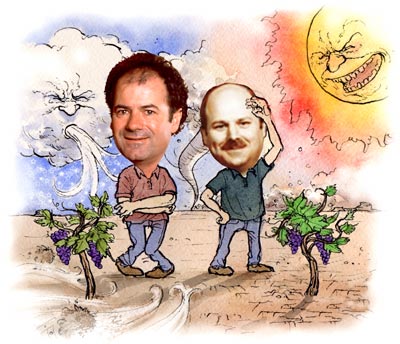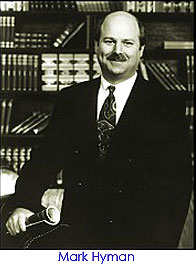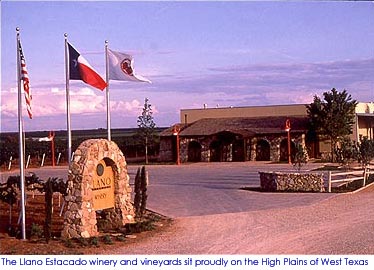

Llano Estacado's Greg Bruni and Mark Hyman, braving the elements in the Extreme Climate of the THP
"...the future for Texas High Plains appellation-based wines has become a reality not only for wineries on the Plains, but also for wineries in other districts that recognize our quality and are producing THP appellation products."
by
Adam Dial
April 13, 2004
AA:
The vastness of Texas, a state that exceeds the size of France, takes in a wide range of terrain and climate. The state’s two largest regions, Texas High Plains and Texas Hill Country, are separated by more than 200 miles. Yet most wine drinkers would still pigeonhole all Texas wine as merely that, ‘Texas wine’. The assumption that all Texas wines are alike might be as unreasonable as the suggestion that Bordeaux, Burgundy, Alsace and Champagne are all alike because they all come from France. Why do you think consumers for the most part have not become familiar with the diversity that exists in Texas winegrowing?
MH: Lack of maturity of the Texas wine industry. Remember, our renaissance is less than three decades old, while France’s wine industry goes back centuries. The Texas wine industry is still avidly experimenting and learning what grows best…and where.
GB: The development of the Texas wine industry has occurred to a great extent without the leadership of trained viticulturists and/or enologists. As a result it has only been recently that the true development of our Texas AVA’s is becoming significant. In other words, if we are struggling just to grow the grapes and make the wine in a commercially correct manner, the appellation is irrelevant. The more trained professionals we acquire in the industry the more significant the AVA’s will become, because only then will we be able to truly evaluate the terroir.
AA: Llano Estacado was in the first wave of post-prohibition wineries in the state of Texas, first opening its doors in 1976. Llano was already well established when you both arrived in 1993 -- shortly after THP had achieved AVA status. Has it been part of your personal mandate to develop the identity and promote not just the image of the Llano Estacado winery, but also the Texas High Plains region itself?
 MH: The AVA’s are important, but once again, we’re still trying to see just which varieties grow best…and where; we currently work with grapes from several AVA’s.
MH: The AVA’s are important, but once again, we’re still trying to see just which varieties grow best…and where; we currently work with grapes from several AVA’s.
GB: In the mid 1970’s the major State Universities of Texas set upon a collaborative effort to study the potential for grape growing and wine making in Texas. At that time university researchers developed a large body of experimental work. This excellent body of scientific work established many of the basic parameters of growing grapes across Texas, in our (diverse) continental climate. For whatever reason, the good science developed by the university system was inconsistently applied to the commercial vineyards that were being developed both on the THP and in other locations across the state. When I came to Texas ten years ago, many of these original vineyards on the THP (but not all) were being pulled up because they were not economically viable. For this reason I was not initially sold on the idea of the THP appellation. In recent times, as science has been applied to new vineyard development, we are beginning to catch a glimpse of the quality potential and economic viability of THP. Llano is now sourcing about 25% of its grapes from the THP appellation and the future for THP appellation-based wines has become a reality not only for wineries on the Plains, but also for wineries in other districts that recognize our quality and are producing THP appellation products.
AA: How would you distinguish the Texas High Plains from other regions of the state in terms of its unique growing conditions and terroir?
 GB: As you know the Southwest is an area of great contrasts. On the THP you are exposed to the most extreme of all contrasts:
GB: As you know the Southwest is an area of great contrasts. On the THP you are exposed to the most extreme of all contrasts:
Climate:
Our mean temperature is 59 F, and degree-days from bud break to harvest ranges between 2,400 and 2,700. In July, temperatures often exceed 100 F, however the high elevation (entire region between 2,900-3,500 feet) and the presence of wind reduces grape temperatures by 20 F, making this region cooler than most areas along a similar line of latitude. Another very important feature is the frost-free period in Lubbock County of 211-days. The mean dates for last (spring) and first (fall) frosts are April 7th and November 4th, respectively. The mean annual precipitation for Lubbock County is 18.3-inches. Most of the rainfall occurs during the warm season (April–October) in the form of thunderstorms, helping meet irrigation needs during “grand growth” and reducing irrigation during maturation.
Other important features include: the relative abundance of water from the Ogallala Aquifer (underground water supply) for irrigation, which may not be ample water for cotton, but is sufficient for grapes; the low relative humidity (at noon the mean average relative humidity during July-September is less than 40%, meaning an absence of mold, fungi, and mildew); plus a general absence of Pierce’s Disease, insect pressure, and soil-borne diseases (except occasional nematodes) in the THP.
Terrain and Soils:
The THP is nearly level (0-3%) with soils that are well drained and calcareous (magnesium carbonate) in nature. Soil depth ranges from very shallow to deep (typically 10-80 inches), and in most areas there exists a complex of very fragile soils. A small difference in our soil composition has a significant impact on the vine and resulting wine. For example one of our growers will plant Mourvedre on “Amarillo Loam Fine Sand” but not on “Amarillo Fine Sandy Loam”.
In general our soils are friable (brittle and crumbly) at the surface and even to depths of 46-inches in some locations. Also, shifting of soil occurs by wind. The soils are moderately alkaline throughout the root zone, with variable reddish, pink or brown sandy clay-loam, and contain about 20% calcium carbonate by volume. Surface runoff is medium, permeability is moderate and available water capacity is high. In most areas the root zone is from 47-80 inches
MH: Lack of maturity of the Texas wine industry. Remember, our renaissance is less than three decades old, while France’s wine industry goes back centuries. The Texas wine industry is still avidly experimenting and learning what grows best…and where.
GB: The development of the Texas wine industry has occurred to a great extent without the leadership of trained viticulturists and/or enologists. As a result it has only been recently that the true development of our Texas AVA’s is becoming significant. In other words, if we are struggling just to grow the grapes and make the wine in a commercially correct manner, the appellation is irrelevant. The more trained professionals we acquire in the industry the more significant the AVA’s will become, because only then will we be able to truly evaluate the terroir.
AA: Llano Estacado was in the first wave of post-prohibition wineries in the state of Texas, first opening its doors in 1976. Llano was already well established when you both arrived in 1993 -- shortly after THP had achieved AVA status. Has it been part of your personal mandate to develop the identity and promote not just the image of the Llano Estacado winery, but also the Texas High Plains region itself?
 MH: The AVA’s are important, but once again, we’re still trying to see just which varieties grow best…and where; we currently work with grapes from several AVA’s.
MH: The AVA’s are important, but once again, we’re still trying to see just which varieties grow best…and where; we currently work with grapes from several AVA’s.
GB: In the mid 1970’s the major State Universities of Texas set upon a collaborative effort to study the potential for grape growing and wine making in Texas. At that time university researchers developed a large body of experimental work. This excellent body of scientific work established many of the basic parameters of growing grapes across Texas, in our (diverse) continental climate. For whatever reason, the good science developed by the university system was inconsistently applied to the commercial vineyards that were being developed both on the THP and in other locations across the state. When I came to Texas ten years ago, many of these original vineyards on the THP (but not all) were being pulled up because they were not economically viable. For this reason I was not initially sold on the idea of the THP appellation. In recent times, as science has been applied to new vineyard development, we are beginning to catch a glimpse of the quality potential and economic viability of THP. Llano is now sourcing about 25% of its grapes from the THP appellation and the future for THP appellation-based wines has become a reality not only for wineries on the Plains, but also for wineries in other districts that recognize our quality and are producing THP appellation products.
AA: How would you distinguish the Texas High Plains from other regions of the state in terms of its unique growing conditions and terroir?
 GB: As you know the Southwest is an area of great contrasts. On the THP you are exposed to the most extreme of all contrasts:
GB: As you know the Southwest is an area of great contrasts. On the THP you are exposed to the most extreme of all contrasts:
- Extreme cold during winter -- in the form of dry polar Canadian air masses leading to sharp drops in temperatures. It is not uncommon to see winter temperatures drop to the low teens (lowest on record is –17 degrees F, in Lubbock County).
- Extreme heat during the summer (dry steppe climate). I have seen 17 days in a row of +100 degree F afternoon temperatures during bloom.
- Extreme wind -- prevailing wind is from the southwest Nov–April; and southerly May-Oct. At noon wind speeds average 13-mph. What I used to call wind in the Central Coast of California is considered a breeze on the plains -- every day prevailing 10-20mph with higher gusts (45-60mph). On an extreme day we have such drastic windstorms that the static electricity developed by blowing sand causes flower clusters to burn!
- Tornado activity brings violent rain and unbelievable hail.
- Spring frost can come after weeks of warm weather to totally decimate a crop (or sometimes the vineyard).
Climate:
Our mean temperature is 59 F, and degree-days from bud break to harvest ranges between 2,400 and 2,700. In July, temperatures often exceed 100 F, however the high elevation (entire region between 2,900-3,500 feet) and the presence of wind reduces grape temperatures by 20 F, making this region cooler than most areas along a similar line of latitude. Another very important feature is the frost-free period in Lubbock County of 211-days. The mean dates for last (spring) and first (fall) frosts are April 7th and November 4th, respectively. The mean annual precipitation for Lubbock County is 18.3-inches. Most of the rainfall occurs during the warm season (April–October) in the form of thunderstorms, helping meet irrigation needs during “grand growth” and reducing irrigation during maturation.
Other important features include: the relative abundance of water from the Ogallala Aquifer (underground water supply) for irrigation, which may not be ample water for cotton, but is sufficient for grapes; the low relative humidity (at noon the mean average relative humidity during July-September is less than 40%, meaning an absence of mold, fungi, and mildew); plus a general absence of Pierce’s Disease, insect pressure, and soil-borne diseases (except occasional nematodes) in the THP.
Terrain and Soils:
The THP is nearly level (0-3%) with soils that are well drained and calcareous (magnesium carbonate) in nature. Soil depth ranges from very shallow to deep (typically 10-80 inches), and in most areas there exists a complex of very fragile soils. A small difference in our soil composition has a significant impact on the vine and resulting wine. For example one of our growers will plant Mourvedre on “Amarillo Loam Fine Sand” but not on “Amarillo Fine Sandy Loam”.
In general our soils are friable (brittle and crumbly) at the surface and even to depths of 46-inches in some locations. Also, shifting of soil occurs by wind. The soils are moderately alkaline throughout the root zone, with variable reddish, pink or brown sandy clay-loam, and contain about 20% calcium carbonate by volume. Surface runoff is medium, permeability is moderate and available water capacity is high. In most areas the root zone is from 47-80 inches














